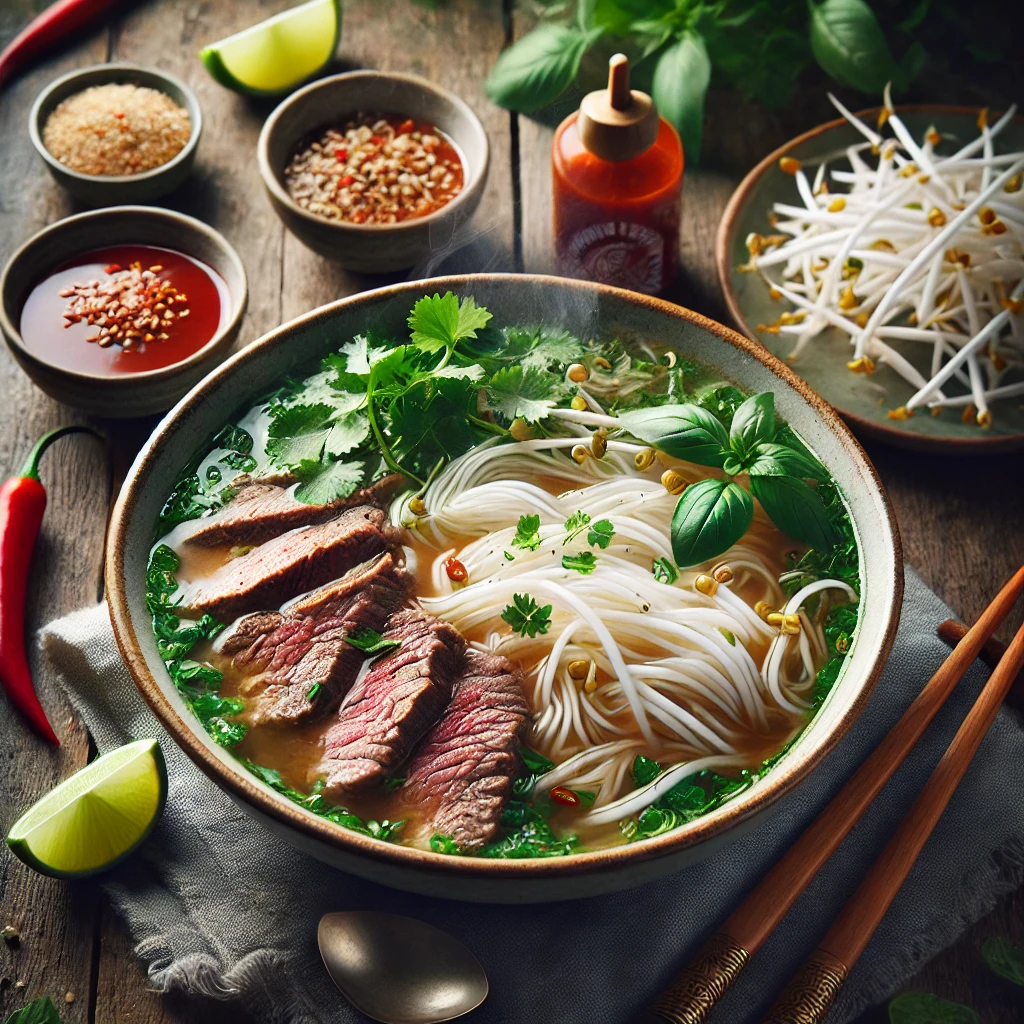The Origins of Pho: A Culinary Journey Through Time
The history of pho is as complex and layered as the broth itself. Pho emerged in northern Vietnam in the early 20th century, during a time of French colonial rule. The exact origins are debated, but it is widely believed that pho was born out of the fusion between French and Vietnamese culinary traditions.
The French influence is evident in the use of beef, which was not a traditional meat in Vietnamese cuisine until the colonial period. The French introduced beef and the idea of making broth from bones, which Vietnamese cooks adapted into their cuisine. The name “pho” is thought to be derived from the French word “pot-au-feu,” a traditional French beef stew.
Initially, pho was sold by street vendors who carried the ingredients and a small stove on their shoulders, setting up shop wherever they found hungry customers. Over time, pho became more than just street food; it became a symbol of comfort and home for many Vietnamese, especially during times of war and hardship.
The Anatomy of a Perfect Pho Bowl
Pho is a delicate balance of flavors, textures, and aromas. A traditional bowl of pho is composed of several key elements: the broth, the noodles, the meat, and the garnishes. Each component plays a crucial role in creating the perfect harmony that pho is known for.
The Broth: The Heart and Soul
The broth is the foundation of pho and is what sets it apart from other noodle soups. A well-made pho broth is clear yet richly flavored, with a depth that comes from hours of simmering bones, usually beef or chicken, along with a variety of spices.
The key spices include star anise, cinnamon, cloves, cardamom, and coriander seeds. These spices, along with onions and ginger, are often charred before being added to the broth, which helps to deepen the flavor and gives the broth its characteristic warmth and complexity.
Patience is essential when making pho broth. The bones need to simmer for at least 6 to 10 hours, allowing the collagen to break down and create a silky, flavorful base. During this process, it’s crucial to skim off any impurities to keep the broth clear.
The Noodles: The Backbone
Pho noodles are flat rice noodles, known as “banh pho.” These noodles are soft yet resilient, providing a perfect contrast to the richness of the broth. Fresh noodles are preferred for their texture and flavor, but dried noodles are also commonly used.
The noodles are cooked separately from the broth to maintain their texture. They are briefly blanched in hot water just before serving to warm them up without making them soggy.
The Meat: The Star of the Show
The choice of meat can vary, but the most traditional version is “pho bo,” or beef pho. The beef can be served in several ways: thinly sliced raw beef (which cooks in the hot broth), brisket, flank, or even meatballs. In northern Vietnam, pho is often simpler, with just a few slices of beef, while southern variations might include a wider variety of meats and even tripe or tendon.
Chicken pho, known as “pho ga,” is also popular, especially in Hanoi. The chicken is typically poached, and the broth is lighter and more delicate than its beef counterpart.
The Garnishes: The Finishing Touches
One of the joys of pho is the array of garnishes that allow each diner to customize their bowl. Traditional garnishes include fresh herbs like cilantro, Thai basil, and sawtooth coriander, as well as bean sprouts, lime wedges, and sliced chili peppers.
In southern Vietnam, pho is often served with hoisin sauce and sriracha on the side, allowing diners to add a touch of sweetness or heat to their liking. In the north, the broth is typically left unadulterated, with garnishes used more sparingly.
The Art of Eating Pho
Eating pho is as much an experience as it is a meal. The first step is to taste the broth before adding any garnishes or condiments. This allows you to appreciate the depth of flavor that has been developed through hours of simmering. After tasting, you can begin to personalize your pho by adding herbs, sprouts, lime juice, and sauces.
When eating, use chopsticks to lift the noodles and meat, and a spoon for the broth. It’s perfectly acceptable to slurp your noodles – in fact, it’s encouraged, as it helps to cool them down and enhances the overall flavor.
Variations of Pho: Regional Delights
Pho is not a monolithic dish; it varies significantly across different regions of Vietnam, each bringing its own unique twist to the classic recipe.
Northern Pho
Pho originated in the north, and the Hanoi style is considered the most traditional. Northern pho is characterized by a clear, straightforward broth that is less sweet and less spicy than its southern counterpart. The focus is on the purity of the beef flavor, and the garnishes are kept to a minimum, typically just green onions and cilantro.
Southern Pho
In southern Vietnam, pho has evolved into a more complex dish, with a sweeter broth and a wider variety of garnishes. Southern pho often includes a wider array of meats, such as tendon, tripe, and meatballs. It is also common to find hoisin sauce and sriracha served alongside, allowing diners to customize their broth with these condiments.
Central Pho
While less famous than its northern and southern counterparts, central Vietnam also has its own version of pho, known as “pho Hue.” This version is spicier, reflecting the central region’s love for bold flavors. The broth is often infused with lemongrass and chili, giving it a distinct kick that sets it apart from the milder northern and southern versions.
The Global Phenomenon of Pho
Over the past few decades, pho has become a global sensation. Vietnamese immigrants brought pho to countries like the United States, Australia, and France, where it quickly gained popularity. Today, you can find pho restaurants in almost every major city around the world, each offering their own take on this iconic dish.
Pho’s popularity is due in part to its versatility. It can be enjoyed as a simple street food or as a gourmet dish in upscale restaurants. Its complex yet comforting flavors appeal to a wide range of palates, making it a favorite among both foodies and casual diners alike.
Making Pho at Home: A Labor of Love
While enjoying pho at a restaurant is delightful, there’s something incredibly satisfying about making it at home. The process is time-consuming, but the result is worth every minute spent in the kitchen.
Ingredients:
For the broth:
- 3-4 pounds of beef bones (marrow bones, oxtail, or a mix)
- 1 large onion, halved
- 3-inch piece of ginger, halved
- 5 star anise
- 2 cinnamon sticks
- 4 cloves
- 1 cardamom pod
- 1 tablespoon coriander seeds
- 1 tablespoon sugar
- 1 tablespoon salt
- Fish sauce to taste
For the pho:
- 1 pound of pho noodles (banh pho)
- 1 pound of beef (sirloin, brisket, or flank, thinly sliced)
- Fresh herbs: cilantro, Thai basil, sawtooth coriander
- Bean sprouts
- Lime wedges
- Sliced chili peppers
- Hoisin sauce and sriracha (optional)
Instructions:
- Prepare the bones: Rinse the bones under cold water and place them in a large pot. Cover with water and bring to a boil. Let it boil for 10 minutes, then drain and rinse the bones to remove any impurities.
- Char the aromatics: While the bones are blanching, char the onion and ginger. You can do this by placing them directly on a gas burner or under a broiler until they are blackened on all sides. This adds a smoky depth to the broth.
- Simmer the broth: In a large pot, combine the blanched bones, charred onion and ginger, and the spices. Cover with 6-8 quarts of water and bring to a boil. Once it reaches a boil, reduce the heat to a simmer and let it cook for at least 6 hours, skimming off any impurities that rise to the surface.
- Season the broth: After the broth has simmered for several hours, season it with salt, sugar, and fish sauce to taste. Continue to simmer for another hour to allow the flavors to meld.
- Prepare the noodles and meat: Cook the pho noodles according to the package instructions. Arrange the thinly sliced beef on a plate, ready to be added to the bowls.
- Assemble the pho: Place a handful of noodles in each bowl. Top with the sliced beef and pour the hot broth over the top, which will cook the beef. Serve immediately with fresh herbs, bean sprouts, lime wedges, and chili slices on the side. Add hoisin sauce and sriracha to taste, if desired.
Conclusion: Pho – A Bowl of History, Flavor, and Culture
Pho is more than just a dish; it’s a journey through Vietnam’s history, a testament to its culinary ingenuity, and a comforting reminder of home for many. Whether you enjoy it in a bustling Vietnamese






